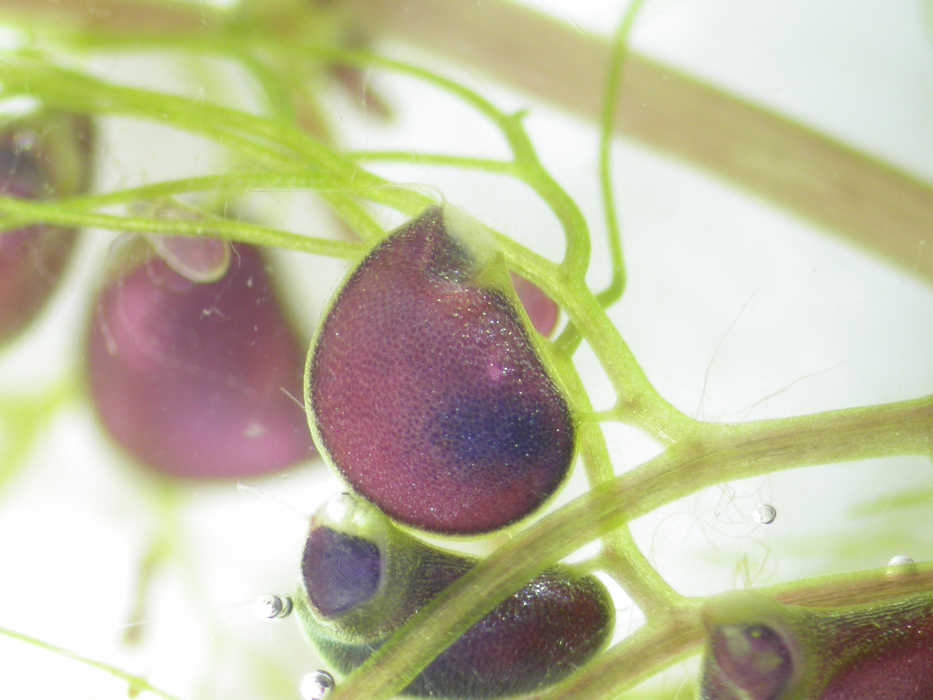Bugs beware: there’s more than just fish in the water!
It’s a very unassuming predator — you might even find it pretty. But it can strike in the span of milliseconds, snatching the bug or small fish that had the misfortune of swimming in the wrong place.
Meet the bladderwort: a small aquatic plant with a big personality.
Carnivorous plants are a subject of fanciful imagination. From pop culture references to legends of man-eating plants, they seem impossibly unusual. They come across as almost extraterrestrial, turning the notion of “animal eats plant” on its head. Yet they’re quite common — the bladderwort is one group out of hundreds of carnivorous plants worldwide.
Carnivory by plants is a common adaptation in response to limited nutrient availability, which is why the bladderwort and its fellow carnivores can flourish in poorer conditions than their solely photosynthetic counterparts. It all comes down to phosphorous and nitrogen. Carnivorous plants are able to obtain these nutrients through their prey, while other plants are limited to the nutrients in the environment around them. However, carnivorous plants can still be successful in areas of plentiful nutrients as long as competition is low.
There are three species of bladderwort in Alaska: the common bladderwort, the flatleaf bladderwort and the lesser bladderwort. All three of these are widely distributed throughout the state, including here on the Kenai Peninsula. There is another species — the swollen bladderwort — that experts believe could become invasive if introduced, but it currently isn’t known to occur here.
The bladderwort genus, Utricularia, is Latin for “little bag,” which refers to the small bladder-like traps it uses to capture its prey. The opening of each bladder is covered with small hairs that work like triggers. In its resting state, the bladder is closed and flat. When an unsuspecting organism happens to bump these hairs, the bladder swells rapidly like a balloon being inflated, drawing in water and victim alike by vacuum force. The trapdoor closes, leaving the organism imprisoned with no chance of escape. From there, the bladderwort secretes enzymes to break down the organism and obtain its nutrients.
Aquatic invertebrates such as insect larvae and water fleas are Utricularia’s prey of choice but it will also consume small fish if given the opportunity. By small, I mean very small — the bladder of a fully-grown bladderwort is only around two millimeters in size. It’s not uncommon to find small tadpoles and fish halfway inside, with the portion inside the bladder completely digested.
The bladderwort isn’t all bite — or should I say — bloat. It’s an important piece of nature’s puzzle, serving a variety of purposes. Fish often utilize the bladderwort for both food and cover. Muskrats and waterfowl can also be seen munching away at dense patches of bladderwort. Even aquatic invertebrates can use the bladderwort for habitat — they just have to watch where they swim.
In the winter, it hunkers down in the form of a dense sphere of plant matter about four centimeters across called a turion. Because the turion is so dense, it sinks to the bottom of the pond or lake. It will lie there, dormant, for the winter while it waits for warmer waters. Like the bud on a tree, this turion will give rise to the next generation of bladderworts when conditions again become favorable. Once the weather improves, all the plant needs to do is elongate its stem — bladderworts are free-floating, so they do not require roots.
Now, with summer in full swing, the bladderwort is starting to convert to its free-floating plant status. It’s difficult to see from the surface because it’s a submersed plant, but soon it will begin producing emergent flowers — usually around late summer. Its flowers are shaped like those of a snapdragon and yellow in color.
So while you’re out enjoying all the aquatic activities the Alaskan summer has to offer, keep an eye out for a pretty little plant with a pretty big appetite.
Jenny Archis is an undergraduate biological intern at the Kenai National Wildlife Refuge. Find more information at fws.gov/refuge/kenai/ or facebook.com/kenainationalwildliferefuge.

